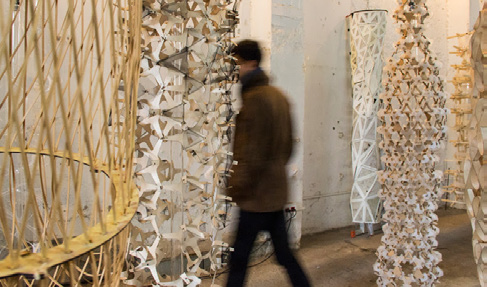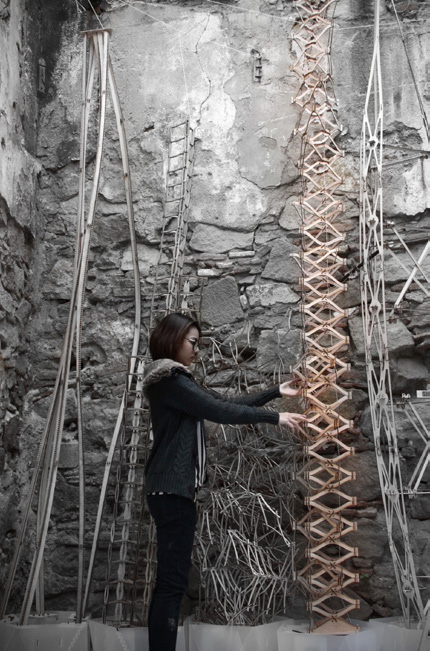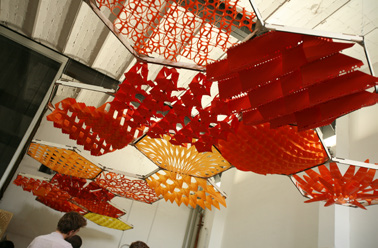INTRODUCTION TO DIGITAL FABRICATION
Tutor : Alexandre Dubor
Tutor Assistant : Djordje Stanojevic, Ricardo Valbuena, Matteo Guarnaccia
Machine assistant : Tomas Martin Agudo, Kunaljit Singh Chadha,
Guest Jury : Martin Seymour


MAA 2014-15 – Digital Fabrication Seminar
Digital Fabrication is an introductory course on new production techniques through the relation between computer data and machine oriented fabrication.
CNC machines were introduced in the middle XXth century into industry, changing the conception of the production of objects and parts (mainly in automotive and military industries, and then into mass consumed products). The relationship between architecture and digital fabrication CAD / CAM processes in architecture is not new anymore, it started during the last two decades of the XXth century, bringing in a new relationship that is not only affecting the way architecture is produced, but is changing the way machines are constructed and conceived for the production of architecture.
At first, the relation between architecture and digital fabrication has been focused on the production of non-standard parts / components and on the speculation of forms as an end itself. Instead we will focus on shapes and machines as a mean to develop performance based design with efficient fabrication methods.
Aims
The aim of the course is to explore the design opportunities arising from three common digital fabrication process : Laser Cutting, CNC milling and 3D Printing.
Assignments will be supported by an iterative exploration of each technology and material, going through conceptual and prototyping process of design each week.
By the end of the course, every student should be familiar with digital modeling, fabricating, documenting and assembling a structure. Students should be able to invent strategies to translate geometry into an articulated constructible solution, produce the CAD – CAM file for production and use the CNC machines by themselves. During the course, students will also learn the principle of a FabLab and learn how to use this collaborative makerspace in a safe, clean and respectful way.
Exercise
The exercise of this year will be the design of 3 lamp exhibiting your exploration of the given material, digital fabrication machine and fabrication strategy.
Students are asked to be creative in the structural design, the joinery system, the perforation distribution and the resulting pattern of light. The final designs must :
Integrate the light bulb and suspension system provided.
Respect machine specific constraints (see further)
Each group will produce a separate object in each of the 3 machines. The 72 object produced collectively by the end of the class will be part of a common exhibition in the institute, showcasing the variety of solutions and techniques made possible by those technologies.
The bulb and the suspension system will be provided by IAAC.
Methodology
The 9 week class will be divided in 3 modules of 3 week (one machine per modules) structured as follow :
- A week to learn how to use the machines and understand its capacity and constraints
- A week to test your concept, fabricating a small prototype
- A week to produce your final prototype.
Students will work in teams of 3 or 4 as defined in the Spreadsheet “DigiFab16 Group Distribution”.
During the span of the exercise, students will work towards the final project by small steps, executing a series of material and machine tests. Each week teams are requested to bring new implementation of the work, incorporating a novel aspect of the digital fabrication technique.


The review will only be based on physical samples of the work and may possibly make reference to photos or diagrams published on the shared google drive as jpg. no need for presentation slides, and digital 3D model will be avoided during the review.
The work to be developed implies both manual and digital experimentation. In one hand, manual experimentation allow for fast exploration and easy understanding of the material properties and system. In the other hand, digital experimentation allow to understand the machine logic and capacities while adding precision and mass customization to the fabrication process.
You have the weekdays (and weekends!) to work and prepare the material you will show us. For the tutorials, make sure that you turn up with your work well prepared, printed if needed and your physical tests documented.